What if there was a guide that could give you ALL the information you wanted to know about environmental allergies? Where here it is! I created this guide because environmental allergies zap our energy, give us miserable symptoms, and prevent us from fully enjoying the great outdoors.

Did you know that Worldwide, allergic rhinitis affects between 10% and 30 % of the population? – aaaai.org
That means that out of every 10 people you know, 1 to 3 of them experience allergy symptoms…yikes.
I wrote this guide because I am allergic to the environment, take a look for yourself.

These are my actual allergy test results AFTER two years of allergy shots (aka my first tests were even worse).
The goal of this guide is to arm you with all the information you need to become your own expert on the topic and to alleviate any suffering you are experiencing from environmental allergens.
As an Amazon Associate, I may receive compensation from qualifying purchases.
What are environmental allergies?
Environmental allergies are simply your immune system overreacting to a substance in your “environment”. Most of the time we are talking about outdoor allergens, but this can also include your workplace or home.
Seasonal vs environmental allergies
Seasonal allergies versus environmental allergies, what’s the difference? Through my extensive research, I have come to this conclusion: Seasonal and environmental allergies are the same…mostly.
The two differences I have found are seasonal allergies usually only last one season for the sufferer. The other difference I found is the topic “environmental allergies” usually also includes environmental irritants.
Back to environmental allergies!
Most common environmental allergens
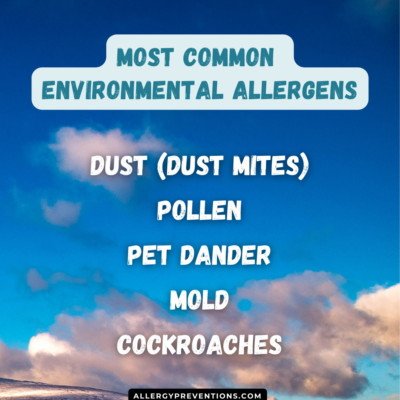
The ACAAI has compiled a list of the most common environmental allergens, and here is the list.
List of Environmental Allergies
- Dust (dust mites)
- Pollen
- Pets (dander)
- Mold
- Cockroaches
Dust Mites
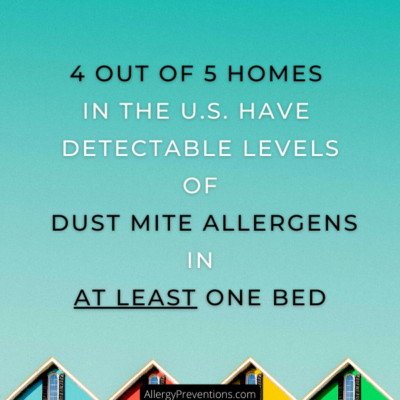
Dust mites are little mites that eat dead human skin cells. Usually, dust mites pose no threat, unless you have a dust mite allergy. Dust mites like humid environments and usually live in fabrics like bedding, curtains, mattresses, carpets, etc.
According to the American Lung Association, roughly 4 out of 5 homes in the United States have detectable levels of dust mite allergens in at least one bed.
Dust mites pose risks for those with dust mite allergies and or asthma. Symptoms range from just a runny nose, all the way up to an asthma flare-up.
How to Reduce Dust Mites
Incorporate the following recommendations to lower dust mites in your home.
Clean and dust often
Dust mites love dust, so reducing the dust can reduce the dust mites. When you are dusting it is recommended to wear a mask if you have a dust mite allergy. Additionally, ensure you are using a duster that traps the dust, not just push it around.
Our family uses Force of Nature cleaner to dampen a washcloth for dusting. This prevents dust from becoming airborne AND disinfects the surface naturally.

Feel free to check out the full review here: Force of Nature Cleaner Starter Kit Review
Wash your bedding
Weekly washing of your bedding and stuffed animals is recommended once a week in hot water. The water needs to be above 130F to kill the dust mites. By laundering your sheets weekly, you are removing the dust mites, and the dust mite food (your dead skin cells).
Get rid of Carpets and Rugs
Carpets and rugs are a safe place for dust mites to thrive. If you can swap out carpets and rugs for a smooth cleanable surface, this will help drastically in reducing dust mites. Replace carpet for hard floors is spendy, or you might be in a rental so it may not be possible.
If this is the case, vacuum weekly with a vacuum that has a HEPA filter. The HEPA filter will prevent dust mites and other allergens from becoming airborne and blowing around your home.
Decrease Humidity Levels
Humidity is the amount of moisture in the air, and dust mites enjoy humidity. What should you do? Lower that humidity! Lowering the moisture in the air to below 50% creates an unpleasant environment for dust mites.
If you are unsure of the humidity levels in your home, you can pick up a hygrometer for a very decent price (around $10) from Amazon.
This one here should get you on the right track.

Get a Dehumidifier
Are you ready to lower the humidity in your home? A dehumidifier is the tool you need for the job. The size of the dehumidifier you need will depend on room size, and how often you want to empty the collection bucket. For a bedroom, I would check out the SEAVON Dehumidifier.

Features:
- Affordable
- Good for small spaces
- Comes with a “sleep mode”
- Very quiet
- Auto shut-off
- 1-year warranty
Pollen Environmental Allergen
Great for plant reproduction, but is a drag for those of us with pollen allergies. Pollen is released by many types of grass, trees, flowers, and weeds. The heaviest season for pollen is springtime and the peak month of April.
How to reduce pollen

These tiny particles easily float through the air and attach to our clothes and pets. Take these steps to reduce your pollen exposure.
Remove shoes
When you have been out and about during the pollen season, shoes may be tracking pollen indoors. By removing shoes when you get in your home, you are preventing whatever is on your shoes from spreading throughout the house.
Change your clothes
Clothing does a great job of capturing pollen spores/grains, which can leave you with allergy symptoms all day. By changing into new clothes, you are stopping the pollen from getting on the couch, in the bed, etc. And you are getting it off your body.
Wash your hair
Your hair may need a good rinse after being outside. Hair is another great place pollen likes to hang out. Rinse your hair at least before you go to bed, so you do not contaminate your bedding.
Keep windows closed
Window screens do not stop pollen, pollen is too small. Keep windows closed if you can. Open windows let the allergens blow right into your home or car, leading to pollen allergy symptoms inside your home and vehicle.
Clean / dust often
Sometimes you just need to do a good cleaning to get rid of any pollen that has already settled in your home. Consider using a wet washcloth to fully trap the pollen and dust so it does not become airborne.
Vacuum
Vacuuming is a great way to suck up allergens if your vacuum is equipped with a HEPA filter. If your vacuum does not have a HEPA filter, there is a good chance that you will just be blowing dust and allergens throughout the house.
For those of you who have a vacuum with a HEPA filter, don’t forget to replace the filter! HEPA filters are not washable and do not last a lifetime.
Wash your pets
Pets that are allowed outside will get pollen stuck in their coats or fur. To prevent your pet from bringing pollen indoors, they will need a bath. Brushing regularly to remove shedding and undercoat may help as well. Just brush them outside if possible.
Wear a mask outdoors
A cloth mask is sufficient for stopping the majority of pollen from getting into your nose and lungs. Since COVID kicked off, we all have masks handy. Now you can wear them for allergy reduction as well! Just remember to wash your mask often to remove contaminants.
Run a HEPA filter
HEPA filters are my favorite! They remove over 99% of everything airborne. I am talking about pollen, mold, dust, viruses, bacteria, dander, and more. Using an air purifier will give you fresh air while indoors and could honestly change your life. We have been using the same air purifier for years with no problems. If interested, check out our full review: WINIX PlasmaWave 5500-2 True HEPA Air Purifier Review
Mold Allergens
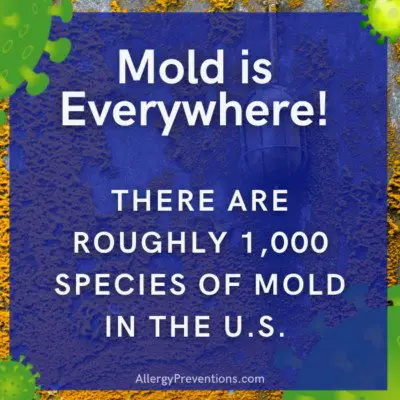
Mold is everywhere! According to acaai.org, “there are roughly 1,000 species of mold in the United States”. Additionally, mold is found in basements, bathrooms, under sinks, and near leaks. Any moist area inside or outside your home is at risk for growing mold.
Reducing Mold
- Run a dehumidifier
- Cleanup/ dry any spills, especially on the carpet
- Use the exhaust fan when showering
- Remove piles of decomposing leaves
- Clean out gutters
- Change HVAC filters
- Use an Air Purifier
Cockroach Allergy
A cockroach allergy can cause environmental allergy symptoms. AAFA.org explains that cockroach allergies are caused by an allergic reaction to saliva, waste, and body parts (even dead cockroaches). Medical professionals suspect that if you have environmental allergy symptoms all year, cockroaches may be to blame.
Reducing Cockroach Allergens
Getting rid of cockroaches is going to be the best practice to alleviate allergy symptoms. To reduce and hopefully remove cockroaches, you will need to deny them access to your home, food, and water. Here are some tips for evicting these unwanted guests.
Tips for Getting Rid of Cockroaches

Deny access to food
- Clean under stove / refrigerator
- Sweep up all crumbs
- Leave no dirty dishes out
- Use airtight food containers
- Do not leave pet food accessible
Deny access to water
- Fix all leaks (faucets, roofs, pipes, basement)
- Run the vent during showers
- Pick up pet water bowls at night
Deny access to your home
- Seal cracks throughout the home
- Entryways
- Garage doors
- Baseboards
- Windows
- Foundation
- Crawlspace
- Consider using baits
- Hire a Professional
Pest management cannot be accomplished by using chemicals alone. The most effective way to keep all pests at bay is to deny them access to food, water, and housing. Contact a local pest manager for additional tips.
Pet Dander
Pet dander is considered an environmental allergen. When we hear “pet dander allergy”, we are usually speaking of cats and dogs, but you may be allergic to other household pets as well. Pet dander is from the skin, saliva, and urine of pets.
Reducing Pet Dander

The Humane Society provides great tips for reducing pet dander in your home.
- Create an “allergy-free” zone
- No pets are allowed in certain rooms so you can have some relief
- Use a waterproof mattress cover
- Protecting your mattress with a mattress cover will prevent dander, pollen, and dust mites from giving you allergy symptoms at night
- Use a HEPA air cleaner
- HEPA filters/air purifiers are highly effective at grabbing airborne particles like dander
- Clean or remove cloth surfaces
- Dander and other allergens get trapped in curtains, couches, carpets, clothes, bedding, and more
- Clean these items, and replace them if you can (i.e. vinyl floor instead of carpet)
- Bathe your pet weekly
- Frequent bathing of your furry friends will keep dander buildup at bay
Environmental irritants
Environmental irritants are often grouped with environmental allergies but are not the same thing. An irritant is something that irritates your body (does not like it) and causes symptoms. The relation between environmental irritants and allergens is they produce similar symptoms.
The ACAAI recognizes these environmental irritants as the most common.
Common Environmental Irritants
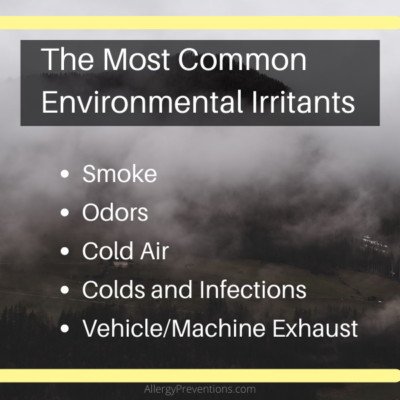
- Smoke
- Odors
- Cold Air
- Colds and Infections
- Exhaust
Smoke
Smoke is a big environmental irritant. Have you ever gotten smoke in your eyes? Ouch! It is best to avoid all smoke for your health and your allergies.
Sources of smoke
- Tobacco smoke
- Campfires
- Woodburning Stoves / Fireplace
- Hobbies (i.e. woodburning, laser etching)
- Charcoal grills
- Meat smokers
- Wildfires
- Burn pits
- Brush fires
Odors
Odors are considered environmental irritants; they can leave you with unpleasant symptoms and are generally bad for your health.
Environmental odor examples
- Perfumes/colognes
- Aerosols
- Hair spray
- Dry shampoo
- Acetone
- Paints
- Gasoline
- Air fresheners
- Household Cleaners
- New carpet or vinyl flooring (off-gassing)
Cold Air Irritation
The ACAAI put cold air as an example, I get it. It is in the environment and can cause irritation to the lungs and nasal passages. They recommend wrapping your face up with a scarf to prevent damage and irritation.
Colds and infections
Colds and infections can give you allergy-like symptoms. These illnesses can irritate your mouth, nose, lungs, and sinuses, and are spread from person to person (environment). Ensure you are washing your hands frequently and getting adequate rest to help fight off ailments.
Exhaust
Vehicle and equipment exhaust is considered an environmental irritant. Big cities or areas of traffic congestion, increase your exposure to exhaust.
Ensure you are not warming up your vehicle inside the garage, the fumes can make it into your home. Not only can exhaust fumes irritate your body, but they can also kill you.
Get fresh air and medical assistance right away if you are excessively exposed to exhaust.
Environmental Allergy Symptoms
The symptoms of environmental allergies range from mild to severe. These are the primary symptoms you may experience.
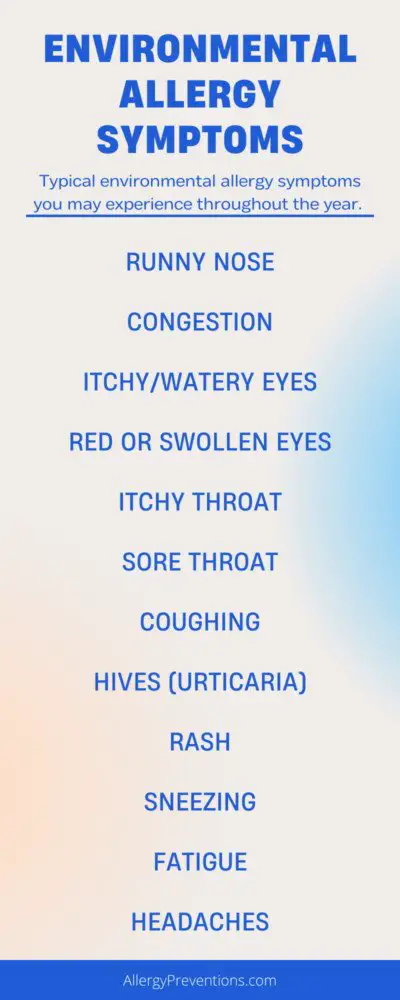
Environmental Allergy Symptoms List
- Runny nose
- Congestion
- Itchy/watery eyes
- Red or swollen eyes
- Itchy throat
- Sore throat
- Coughing
- Hives (urticaria)
- Rash
- Sneezing
- Fatigue
- Headaches
Severe Allergy Symptoms (Seek medical Help)
- Trouble breathing
- Pale/blue lips
- Confusion
- Dizziness
- Diarrhea
- Cramps
- Loss of consciousness
Environmental Allergy Test Options
The testing options to diagnose environmental allergies are limited to skin testing and blood tests. Some medical providers may choose one of these options, or complete both tests.
Blood Test
According to MedlinePlus, an allergy blood test is used to see if you have an allergy by measuring the number of IgE antibodies in your blood. If the IgE (immunoglobulin E) levels in your blood are higher than the normal baseline, you likely have an allergy.
Skin Test
A skin test is also known as a skin prick or scratch test (KidsHealth.org). A skin test is the most common, and specific allergy testing method. To conduct the test, an allergist puts a “scratch” or “prick” on the skin and places a drop of liquid that contains the suspected allergen into the scratch. After about 15 minutes, the medical professionals will look at the scratch site to see if you have a reaction to that specific allergen.
If you have a reaction, you likely have an allergy to the substance they tested.
It is not uncommon for the doctor to test 20 or more allergens in a single session. When I got my skin test completed, they tested me on over 40 allergens.
Environmental Allergy Treatments
These treatment options are mostly centered around treating the symptoms of allergies, not necessarily treating the allergies themselves. Ideally, the less you are exposed to the allergen, the less you will need one of these options.
Decongestants
Decongestants may help with symptoms such as sinus pressure, coughing, and runny/stuffy nose. You can find decongestants over the counter at your local drug store like CVS.
Antihistamines
Histamine is released during an allergic response, which is where your symptoms stem from. To combat the histamine, you may be able to take an antihistamine. A medical provider’s typical first line of defense for allergies is to try an antihistamine.
If you do not take antihistamines already, compare some products and see what works for you. I take Claritin almost every day for my allergies, and it has been working great for years.
Nasal Steroids
Nasal steroids are used for allergy symptoms like runny nose, watery eyes, and sinus pressure. This medication provides some extra assistance to your body when combating allergens. They do take a week or two to get the full benefits, but most people see a big improvement if they stick with it. The most popular nasal steroid right now is flonase®.
Prescription Medications
When over-the-counter and home remedies just aren’t cutting it, you may need to talk with your medical provider to discuss prescription medication options.
Allergy Shots (Immunotherapy)
Allergy shots are a long-term treatment option, that may take 6 months to see any benefits. Some people don’t see any changes in their symptoms, and others swear by their results. There is no guarantee that allergy shots will work but for me, it is worth the risk. I have been on allergy shots for 2 years now, and I do see results.
Discuss with your doctor or allergist to see if allergy shots are the right path for you.
Environmental Allergy Home Remedies
Home remedies are a good start in treating or reducing your allergy symptoms. Here are some proven home remedies for you to experiment with and find relief.
Nasal Rinse / Irrigation
Nasal rinsing is great for cleaning out your nasal passages and sinuses from allergens. Our nasal cavity is an air filter, and that air filter sometimes gets clogged. When you use a nasal rinse, you are unclogging your “filter”. The irrigation liquid is saline water that has the same pH balance as your body, providing you with a painless experience.
Nasal rinsing does take some getting used to, and it is not for everyone. For example, I love it and asked for a new nasal rinse kit for Christmas, but my wife hates nasal rinsing and will never do it again. My recommendation is to give it a try.

Take a Shower
A shower will remove any environmental allergies that may have attached to you while you were out and about. If you do not rinse after being exposed to allergens, you are at risk for experiencing chronic allergy symptoms and spreading allergens throughout your home.
Allergy Medications
Antihistamines are designed to stop allergy symptoms! Antihistamines are a home remedy because you may already have some allergy meds on hand, and they are available over the counter.
Hydrate
Drinking water throughout the day and staying hydrated lets your body work more efficiently. When your body has the fluids it needs, it can work to combat allergens and flush them out of your system. Dehydration can hinder your recovery and you may have allergy symptoms present longer than necessary.
Essential oils
Essential oils such as peppermint, frankincense, and eucalyptus are some allergy sufferers’ “go-to” treatments. Some folks diffuse the oils, and others wear the oils. There have been limited studies on these claims, but it might be worth a try.
Environmental Allergy Prevention Tips
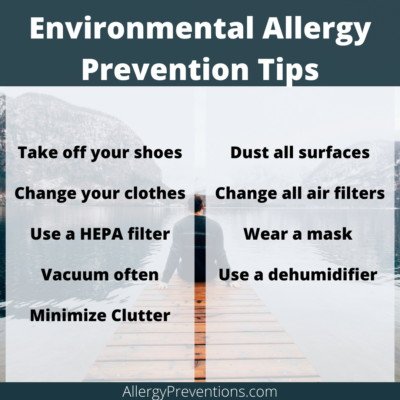
The best treatment for environmental allergies is prevention. These are prevention options to consider when trying to stop your allergies before they even start.
Take off shoes
Shoes bring in outdoor/environmental allergens. Take them off before entering your home. If wearing shoes is a must in your home, pick up a pair of house shoes, or even shoe “booties” will help. We use these house shoes for when we have guests.
Change your Clothes
Clothes tend to trap pollen, mold, spores, dander, and such. Changing your clothes will prevent the spread of allergens.
Use a HEPA filter
Environmental allergens have the ability to be airborne, some stay in the air longer than others. Either way, using a HEPA filter will remove those allergens from the air so you can breathe easily.
Vacuum often
Use a vacuum equipped with a HEPA filter to combat environmental allergens in your home. Dust, dander, pollen, and cockroach parts (allergens) are easily cleaned up with a vacuum. Routine vacuuming will help keep allergic triggers from building up in your carpets and on your floors.
Minimize clutter
Minimizing clutter removes the areas that allergens might be hiding. All allergens can become airborne (to some extent) and land in the nooks and crannies of clutter.
Dust all surfaces
Dusting all surfaces not only leaves your living area looking great, but it removes dust mites, dust, pollen, and mold spores. Dusting is a simple yet effective allergy prevention practice.
Change filters
There are filters everywhere! Find them and clean (if cleanable) or replace them. Here are areas where you may have a filter that needs to be changed.
- Vacuums (robot vacuums too)
- Heating / Cooling unit
- A/C window units
- Cabin air filter (in your car)
- Air purifier
- Fans (if equipped)
Wear a mask outdoors
A face mask does provide a barrier between you and the environment. Therefore, wearing a mask while outdoors will prevent most allergens from getting into your lungs and sinuses.
Use a dehumidifier
A dehumidifier can help prevent allergies from dust mites, and mold. A healthy humidity level to shoot for is around 50% (or a bit lower) when controlling allergens.
Environmental Allergy FAQs
There are frequently asked questions about environmental allergies, from readers just like you!
How do you test for environmental allergies?
Environmental allergies are tested with blood work or a skin scratch test.
How long do environmental allergies last?
Environmental allergy symptoms usually are present until you are no longer exposed to the allergen. Once you remove yourself from the allergen your symptoms should subside.
Is mold an environmental allergy?
Yes, mold is an environmental allergy. Mold can be found inside the home and outside, in moist areas.
Can environmental allergies cause shortness of breath?
Yes, environmental allergies can cause shortness of breath. This is a more severe symptom, and you should seek medical assistance.
What can be done for environmental allergies?
- Avoid environmental allergens
- Dust mites
- Pollen
- Dander
- Mold
- Cockroaches
- Implement prevention measures for your allergen
- Use a nasal rinse
- Wear a mask
- Shower often
- Clean often
- Use a HEPA filter
- Treat
- Antihistamines
- Nasal steroids
- Allergy shots
Can environmental allergies cause hives?
Yes, environmental allergies can cause hives. Hives are an immune system response that can show up as urticaria (hives) when you are exposed to an allergen.
Are seasonal and environmental allergies the same?
Yes, seasonal, and environmental allergies are considered the same. Some allergy sufferers may only have symptoms for one “season”, making seasonal allergies a better fitting term.
Can environmental allergies cause a skin rash?
Yes, environmental allergies can cause a skin rash. A rash from allergies may surface from the allergen touching the skin (contact dermatitis), or systemically (inside the body) after an allergy exposure.
How do you know if you have environmental allergies?
There are three ways to know if you have environmental allergies.
- You experience allergy symptoms when in a specific environment (or time of year)
- Allergic reaction on a skin scratch test
- High IgE blood levels
What is the ICD 10 code for environmental allergies?
The most accurate ICD 10 code for environmental allergies is J30.2 “Other seasonal allergic rhinitis”.
Furthermore, another option is ICD 10 code J30.9 “ Allergic rhinitis, unspecified”.
These codes were pulled directly from the 2022 ICD-10-CM TABULAR LIST of DISEASES and INJURIES.
Also, Check out:

